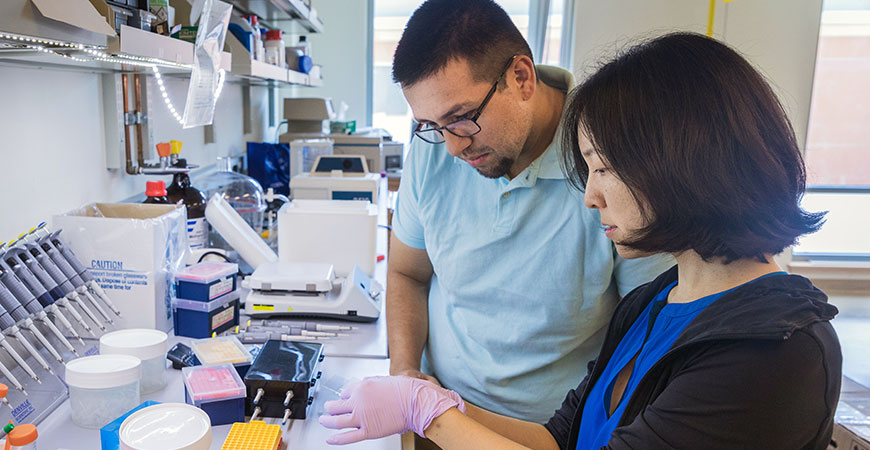
Professor Jing Xu and her students study extremely tiny motor proteins, but their work could make a huge contribution to the growing body of knowledge about Alzheimer’s and other diseases that progressively destroy brain tissue.
Alzheimer's disease is, so far, untreatable and incurable and is the sixth most common cause of death in adults in the United States. An estimated 5.7 million people have the disease. Dysfunction of a protein called tau is the hallmark of Alzheimer’s disease. Xu’s lab is working to understand how cellular cargos navigate around abnormally high levels of tau proteins on microtubules to keep the cells healthy, rather than degenerating.
Such understanding could pave the way for future therapeutics, she said.
She explained the cellular system she’s looking at with a highway analogy:
Imagine the microtubules inside cells are roads. The “cars” on the roadway are lipid membranes containing cellular cargo, and traveling to their destinations using “wheels,” or motor proteins. The cars travel along the roads unhindered unless they come upon a roadblock — tau proteins. If that happens, the cars and wheels need a strategy for navigating the roadblock to ensure cell survival and health. Tau is abundant in human neurons and isn’t always a hindrance to cargo delivery — only when there is too much of it, as when there is a neurodegenerative disease.
With a prestigious R15 Award from the National Institutes of Health (NIH), Xu is studying how changes in the lipid membranes that link the motor protein “wheels” together can help make sure the car navigates the unwanted roadblocks. Understanding these mechanisms could help combat the roadblocking effect of tau on critical cargo delivery.

Xu is an experimentalist working at the intersection of physics and biology. She is with the Department of Physics in the School of Natural Sciences, and is a member of the NSF CREST Center for Cellular and Biomolecular Machines.
Students in her lab use optical trapping — a nano “tractor beam” that won the Nobel Prize in Physics in 1997 and 2018 — to tackle research questions. They shine a tightly focused laser beam onto particles to manipulate the motor proteins at nanometer precision.
“We think the lipid membrane that encloses the cargo is really important for the proper delivery of the cargo,” Xu said. “We can change the car’s delivery by changing its shell.”
Recent data from the Xu lab shows cholesterol, a type of fat found in the membranes, to be a factor.
“When we add cholesterol to the membrane, the roadblocking effect becomes a lot stronger,” Xu said. “Now we want to understand how cholesterol is changing the membrane...Where is the transition? Is there a critical level of cholesterol that we should stay under?”
Xu is excited to engage undergraduate students in these research explorations.
“I started my research career as a sophomore in college. It was a really great experience,” she said. Students interested in taking part in this research can contact her by email.
“This is a great time for research in molecular motor biophysics,” she said. “We have a lot of really amazing tools from the physical sciences that we can use to answer important open questions in biology.”



